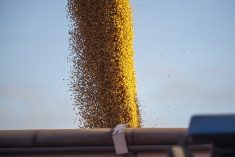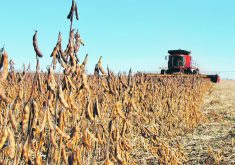Statistics Canada’s November 2024 yield and production survey confirmed expectations. The outlook for corn and wheat remains bullish for the spring period due to tighter ending stocks from major exporters. The soybean market is expected to remain under pressure due to burdensome fundamentals.
Quick look:
Soybeans: Brazil, Argentina and the United States have had a year-over-year increase in production.
Read Also

The forced Japanese-Canadian farmers of the Second World War
Manitoba’s sugar beet farms drew on displaced Japanese-Canadians from B.C. during the Second World War
Corn: Demand for Ontario corn will make its seasonal high in April and May.
Wheat: There is concern the U.S. wheat region will experience a dry spring.
Soybeans
Ontario farmers harvested 4.354 million tonnes of soybeans, according to Statistics Canada. This compares to the 2023 crop of 4.36 million tonnes and the five-year average of 3.92 million tonnes. We estimate that Ontario farmers delivered 3.4 million tonnes of soybeans into the commercial pipeline from Sept. 1 through Dec. 1, 2024.
When Statistics Canada releases its Dec. 31 Stocks Report in February, we expect Ontario on-farm stocks to come in at one million tonnes, while commercial stocks will also finish near one million tonnes.
On Jan. 7, 2024, Ontario elevator bids for soybeans were hovering around $15.68/bu. On Dec. 8, 2024, bids were averaging $12.96/bu. Over the past 14 months, soybean meal futures have dropped from US$530/tonne to US$300/tonne, while soybean oil futures have declined by nearly 15 US cents per pound.
Farmers don’t often realize how soybean crush margins have changed. Argentinean soybean production reached 48 million tonnes, up from the 2022/23 crop of 25 million tonnes. Argentina is the world’s largest exporter of soymeal.
Brazil, Argentina and the U.S. have experienced a year-over-year increase in production for the 2024/25 crop year. The product values will remain under pressure.
Chinese import demand for soybeans for the 2024/25 crop year is estimated at 109 million tonnes, down from the 2023/24 imports of 112 million tonnes. The world’s largest soybean importer has lower demand.
For the Ontario farmer, U.S. soybeans will trade into Ontario in the latter part of the crop year.
What to do: We’ve advised farmers to be 50 per cent sold on their 2024 production. This week, we’re advising farmers to sell 10 per cent, increasing sales to 60 per cent. The soybean market tends to experience a seasonal rally during North American planting period, which is when we will make our next sale. We always sell the final 20 per cent once the upcoming crop is more certain. In a normal year, there is one weather rally during the North American growing season.
Corn
Statistics Canada’s final crop survey had Ontario corn production at 9.627 million tonnes, down from the 2023 crop of 9.977 million tonnes but up from the five-year average of 9.337 million tonnes. Ontario farmers sold 6.2 million tonnes from Sept. 1 through Dec. 31, 2024. On-farm stocks as of Dec. 31, 2024 are estimated at 3.4 million tonnes and commercial stocks will also be 3.6 million tonnes.
Looking forward, demand for Ontario corn makes seasonal highs in April and May. This is when export demand is the strongest for Ontario corn. The Ontario corn market will function to attract farmer selling later in spring as commercial stocks tighten.
On Jan. 7, 2024, Ontario elevator bids for corn were averaging $5.30/bu. At the time of writing this article in December 2024, elevator bids were at $5.50/bu. The U.S. had record corn production in 2023. Despite the lower acres in 2024, growing conditions were near perfect throughout the growing season. Brazil harvested a smaller crop in the spring of 2024, which enhanced demand for U.S. corn in the fall.
The Northern Hemisphere crops in Russia, Ukraine and the EU all experienced a year-over-year decline in production.
To reiterate from previous issues, ending stocks from the major exporters (Argentina, Brazil, Russia, South Africa, Ukraine, excluding the U.S.) are expected to drop to seven million tonnes, down from the 2023/24 carryout of 9.75 million tonnes and down from the five-year average of 14 million tonnes.
The market cannot afford a crop problem in the Northern Hemisphere in the spring and summer of 2025. We’re expecting the futures market to incorporate a major risk premium from March through May.
What to do: We’ve advised farmers to be 50 per cent sold on their 2024 production. We’re planning on making our next recommendation in March or April. We’re very bullish on corn and could see the Ontario market easily rally $1/bu. If the U.S. is drier this spring, watch out!
Wheat
Ontario farmers harvested 2.403 million tonnes of winter wheat, according to Statistics Canada, down from the 2023 crop of 2.847 million tonnes and up from the five-year average of 2.351 million tonnes. For most Ontario farmers, wheat marketing is over.
On-farm stocks as of Dec. 31 were estimated at 425,000 tonnes. Ontario wheat basis levels are expected to strengthen later in spring. On-farm wheat stocks at the end of the crop year are expected to drop to bin-bottom levels.
During January, Ontario soft red winter wheat bids were around $7.25/bu. The wheat market experienced a rally in May with elevator bids reaching up to $8.50/bu. During the spring of 2024, the market incorporated a risk premium due to drier conditions in the U.S. and Russia, while Europe was too wet. The Ontario market made harvest lows on Aug. 29 at $6/bu. At the time of writing this article, Ontario elevator bids were averaging $6.40/bu.
Russia experienced lower wheat production in 2024. The Russian government announced that from Feb. 1, 2025, through June 30, 2025, wheat export quota would be 11 million tonnes, down from 29 last year.
Ending stocks from the major exporters (excluding the U.S.) are expected to finish near 30 million tonnes, down from the 2023/24 carryout of 39 and down from the five-year average of 39. There is less competition in the latter half of the crop year.
Similar to corn, the wheat market is in a situation where it cannot afford a crop problem this spring. Given the lower ending stocks from major exporters, we’re expecting Ontario winter wheat prices to rally $2/bu. during April.
The forecast for the U.S. hard red winter wheat region calls for drier conditions in March and April. Usually, the U.S. Southern Plains receive seasonal rains in April so there is a concern here.
In Russia, winter wheat acres are down about two per cent from last year and below normal precipitation occurred during the fall. The longer-term forecast calls for average to below average precipitation. European production is uncertain. We expect wheat acreage to be marginally lower in France and Germany.
What to do: We’ve advised producers with feed quality wheat to be 50 per cent sold on their 2024 production. Farmers with milling quality should be 30 per cent sold. Given the lower ending stocks from major exporters and current weather forecasts, we’re expecting the Ontario wheat market to rally $2/bu during April. Watch out if drier conditions materialize in Russia or the U.S. Southern Plains. We’ll advise producers with feed quality wheat to also sell in spring as the market will move in line with corn prices.















